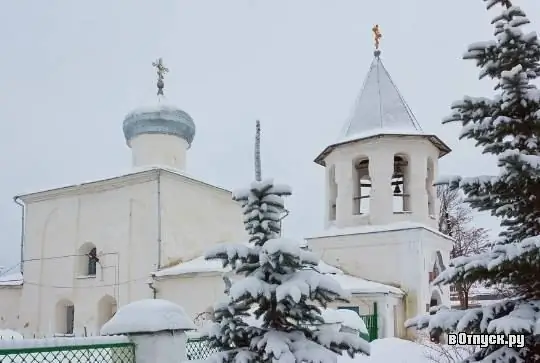
Description of the attraction
The famous church, named after the Protection of the Most Holy Theotokos, was built in the first half of the 17th century from a stone slab on the site of a pre-existing wooden church, built in 1522 on a votive basis during a pestilence. The wooden temple was built during the reign of Grand Duke Vasily III Ioannovich for the money of the grand ducal treasury. In 1590, a fire broke out in the church, and it completely burned down, for which reason it was decided to build a new stone church.
The stone church had two thrones, the main of which was the throne in honor of the Protection of the Most Holy Theotokos; the second throne was consecrated in honor of the Image of Christ the Savior Not Made by Hands. In 1786, the Pskov spiritual consistory adopted a decree to ascribe the Church of the Revealed Saint Nicholas from Torg, as well as the temple of the Great Martyr Barbara to the Church of the Intercession of the Virgin. But at the beginning of 1914, only the Church of the Great Martyr Barbara was assigned to the church. Before the states were introduced in 1876, the church clerk had a deacon, a priest, and two clergymen. According to the states of 1876, a psalmist and a priest were to appear in the temple.
As for the architectural component of the church building, the main quadruple was quite small and had a deaf decorative head in a pillarless interior above a closed vault. Some fragments of paintings dating back to the 19th century, which depict Pskov saints, have been preserved in the church to this day. In a small niche, above the main entrance to the church, there is a 20th century fresco made by the hands of the famous icon painter and archimandrite Zinon.
To a greater extent, the late architectural character is reflected in the construction of a bell tower of the "octagon on a quadruple" type, located above the entrance along the main axis of the entire church, in the place of which there could be a belfry, traditional for the city of Pskov, on one of the bearing walls.
If you do not take into account all the losses and restructuring, then the temple has Pskov, general and rather calm proportions, and the defining setting of the church at the intersection of the main city streets - Bolshaya and Pskovsko-Novgorodskaya, allows us to consider the church quite successfully fitting into the ensemble of the old city of Pskov.
At the Church of the Intercession of the Most Holy Theotokos, a bell tower was built, on which there were nine bells, the weight of the largest of which reached more than 512 kg. On one of the bells, dating back to 1548, there was an inscription that this bell was poured by a master named Pskovitin, as well as his son Prokofey.
Among those who contributed to the needs of the church are: Maria Koroleva, Anna Ermakova, Maria and Sergei Kyurinsky, the bourgeois woman Razumova, Paraskeva Obrazskaya, the state councilor Deryugina, the wife of priest Pavsky and others.
Beginning in June 1896, a parish guardianship began to operate at the church, which helped the poor and poor families of its parishioners. There were no hospitals, almshouses, or a parish school at the church due to an acute shortage of funds. Not far from the church there was a zemstvo women's school, as well as two private schools, while another school existed in the charity house of the poor of St. Mary. In 1904, a parish school was built with the money of the parish trusteeship. At the temple there was a choir of singers, consisting of pupils of the nursing home. The parishioners of the church also took an active part in the process of singing and reading. In 1964, restoration work was carried out on the church bell tower.
On July 15, 1993, the city administration of the city of Pskov made a decision to transfer the Church of the Intercession of the Most Holy Theotokos into the hands of the Pskov diocesan administration. Not only the church of the diocese, but house No. 37, located on Nekrasov Street, was transferred to the diocese for the needs of the new Pskov religious school. It is known that the famous Pskov historian and ethnographer Okulich-Kazarin Nikolai Fomich lived in house No. 37 until his forced departure. Now a memorial plaque is installed on his house.






